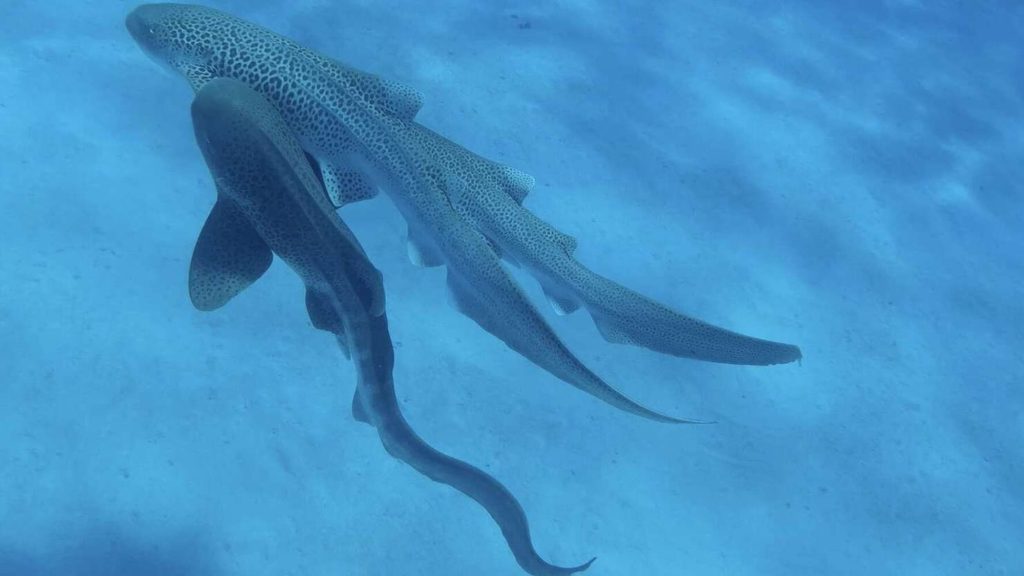Marine biologists recently documented a promising (if intimate) marine moment in the ocean waters near northeast Australia. For the first time, researchers recorded a leopard shark (Stegostoma tigrinum) mating event. But the footage doesn’t showcase a pair of the endangered predators going at it—the brief tryst involved three participants.
Also known as a zebra shark, the leopard shark lives near the coral reefs and sandy ocean shelves of the tropical Indo-Pacific. Pups are born with banded markings that fade into their recognizable, leopard-like spots by the time they reach adulthood, hence the sometimes interchangeable name. A full-grown leopard shark averages about eight feet long and prefers a diet of mostly shelled molluscs, crustaceans, and small fish.
Even after reassessment by the International Union for Conservation of Nature (IUCN) in 2024, the leopard shark is still classified as an endangered animal on the organization’s Red List of Threatened Species. Their primary threats remain environmental destruction and overfishing due to the ongoing demand for its fins, meat, and liver oil. For environmentalists, understanding leopard shark mating habits could offer valuable information for boosting the population and saving the animals from further harm.
Researchers have largely studied the sharks in captivity, although there has been an increased effort to observe them in their natural environments in the hopes of better documenting their natural behavior and outside influences. In one such example, University of the Sunshine Coast marine biologist Hugo Lassauce took weekly snorkelling excursions for over a year to monitor leopard sharks living about 9.3 miles off the New Caledonian coast. In all that time, Lassauce hadn’t the animals “in the act.”
“I’d seen males swimming fast after females before and I’d arrived ‘on the scene’ just after a male and female separated, but I’d never seen the whole sequence,” he explained in a statement.
His luck finally changed one day while approaching a group of the animals, when Laussauce noticed an unfamiliar sight.
“While I was surveying this particular aggregation of leopard sharks, I spotted a female with two males grasping her pectoral fins on the sand below me,” he said.
To ensure nothing accidentally disturbed the trio, Laussauce asked his partner to depart with their boat and give the sharks some space. Then he needed to rely on his patience.
“I waited an hour, freezing in the water, but finally they started swimming up,” he said.
Laussauce was ultimately able to record the males quickly mate in succession with the female—endeavors that respectively lasted 63 seconds and 47 seconds. But while that exertion appeared to tire the males, their third participant was less phased.
“The males lost all their energy and lay immobile on the bottom while the female swam away actively,” said Laussauce.
Although arguably a bit voyeuristic, the documentation marks a major moment in leopard shark conservation efforts, especially for a species that is mostly solitary. According to Christine Dudgeon, a USC researcher and co-author of a resulting study published with Laussace in the Journal of Ethology, the evidence indicates the locale near New Caledonia is a “critical mating habitat.”
“[This] can inform management and conservation strategies as well as help us understand population dynamics and reproductive behaviours more widely,” she said, adding that the new information may also assist artificial insemination research for “rewilding” projects.
While describing the meetup as “surprising and fascinating,” Dudgeon explained there are many new questions to consider. For one thing, it’s still unclear how multiple potential fathers factor into the overall equation.
“From a genetic diversity perspective, we want to find out how many fathers contribute to the batches of eggs laid each year by females,” she said.
Despite the remaining unknowns, Laussauce said he was immediately certain of the documentation’s importance.
“It’s rare to witness sharks mating in the wild, but to see it with an endangered species–and film the event–was so exciting that we just started cheering,” he remembered.


